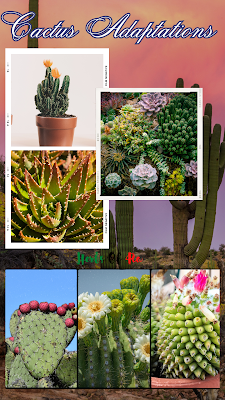Cactus Adaptations
Environments like deserts, dry areas, and semi-barren regions receive less rainfall than other parts of the country, making water scarcity a common problem in these areas. The plants which inhabit these environments have had to adapt to these conditions in order to survive. Desert plants-known as xerophytes-are most often succulents that have reduced, thick leaves. Apart from a few exceptions like Rhodcactus, all cacti are succulent plants. There are some specific cactus adaptations which enable cacti to survive in harsh environments.
The most important cactus adaptations are the ones that allow them to conserve water, such as having reduced leaves. Reduced leaves means reduced surface area, whether by making leaves shorter and thicker, or longer and thinner. This means less water is lost to the atmosphere through evaporation. We know that this is an evolutionary adaptation because of what we see under the microscope. Some other species of cactus have microscopic phloem, xylem and stomata, just like non-succulent plants. There are also ephemeral leaves in some of the cactus species, but these leaves don't last for long during the early development stages of the stem. Opuntia Ficus-indica (prickly pear cactus) is an excellent example of cactus species which has ephemeral leaves as a result of evolution.
Spines for Cactus Adaptations
Some cactus adaptations include spines which let out less water during transpirations then leaves. Spines grow from specialized structures called areoles, and defend the cactus from water-seeking animals. A few members of the spine-cactus family have rudimentary leaves which fall off once the cactus has matured. There are two genera called Pereskiopsis and Pereskia which retain large and non succulent leaves and even non succulent stems.
Cactus Adaptations through Stems
There are cactus plants that have adaptations such as enlarged stems which carry out photosynthesis and store water. These species of cacti (known as succulents) are coated with a waxy substance coated that prevents water evaporation. It helps prevent water from spreading on the surface, instead forcing water down the stem and into the roots. Cacti have hard-walled, thick succulent stem which stores water when it rains and keeps water from evaporating. The stem is basically fleshy, green and photosynthetic, and the inside of the stem is either hollow or spongy tissue to hold water.
Cactus Adaptations
For more information on Cactus Adaptations [http://www.greatcactussale.com/2009/02/17/cactus-adaptations/] come to greatcactussale.com
Article Source: http://EzineArticles.com/?expert=John_J._James
http://EzineArticles.com/?Cactus-Adaptations&id=2110535



Comments